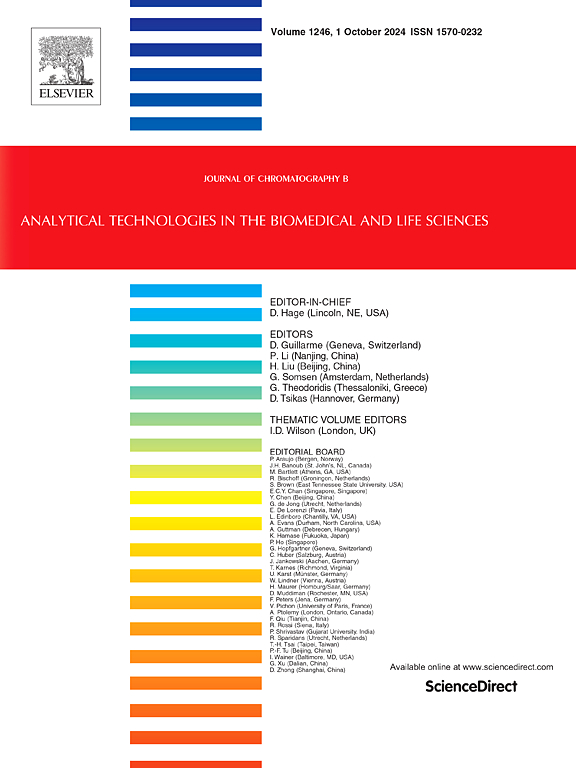Rapid analysis in small-volume urine: Optimizing LC-MS/MS for free glucocorticoids
IF 2.8
3区 医学
Q2 BIOCHEMICAL RESEARCH METHODS
引用次数: 0
Abstract
Glucocorticoids, regulators of energy metabolism and immune responses, are known biomarkers of stress response and disease. Downscaling the required sample volumes facilitates large-scale studies and accelerates the generation of valid results. To meet this expectation, we modified our LC-MS/MS method using 100 μL of urine to that using 20 μL, following the same steps as in the original protocol with the addition of cortisone-d8 as an internal standard. Calibration was performed as in the original protocol but using 1/5 diluted standards, resulting in a good linearity of 2–200 ng/mL in the log-log plot, indicating a lower limit of quantitation (LLOQ) of <2 ng/mL from the residue. The coefficients of variation of the matrix factors of the 15 urine samples and water were within 15 % for 10 and 300 ng/mL cortisol and cortisone. The matrix factor of the downscaled method was larger than that of the original method, especially for urine extracts with high specific gravity (up to 2.1-fold), indicating the advantage of the downscaled method; although the theoretical LLOQ is 5-fold with the 1/5 downscaling, the effect on the practical LLOQ may be reduced by the suppressed matrix effect. The current method showed good recovery, accuracy, reproducibility, and agreement with the original method (regression coefficient close to 1.0). After sample freezing, cortisol and cortisone were detected at higher and lower levels, respectively, within 25 %. The downscaled method of urine-free cortisol and cortisone may contribute to the advancement of related research.
小容量尿液的快速分析:优化游离糖皮质激素的LC-MS/MS
糖皮质激素是能量代谢和免疫反应的调节剂,是已知的应激反应和疾病的生物标志物。缩小所需的样品量有助于开展大规模研究,并加快得出有效结果。为了满足这一期望,我们将使用 100 μL 尿液的 LC-MS/MS 方法改为使用 20 μL 尿液的 LC-MS/MS 方法,步骤与原方案相同,但添加了可的松-d8 作为内标。校准按原方案进行,但使用的是 1/5 稀释标准品,结果在对数-对数图中线性关系良好,为 2-200 ng/mL,表明残留物的定量下限(LLOQ)为 2 ng/mL。对于 10 和 300 毫微克/毫升的皮质醇和可的松,15 份尿样和水的基质因子变异系数在 15%以内。降标方法的基质因子大于原始方法的基质因子,特别是高比重尿液提取物的基质因子(高达2.1倍),表明降标方法的优势;虽然降标1/5后理论LLOQ为5倍,但由于基质效应被抑制,对实际LLOQ的影响可能会减小。目前的方法在回收率、准确度、重现性和与原始方法的一致性(回归系数接近 1.0)方面均表现良好。样品冷冻后,皮质醇和可的松的检出率分别在 25%以内。无尿皮质醇和可的松的降标方法可促进相关研究的发展。
本文章由计算机程序翻译,如有差异,请以英文原文为准。
求助全文
约1分钟内获得全文
求助全文
来源期刊

Journal of Chromatography B
医学-分析化学
CiteScore
5.60
自引率
3.30%
发文量
306
审稿时长
44 days
期刊介绍:
The Journal of Chromatography B publishes papers on developments in separation science relevant to biology and biomedical research including both fundamental advances and applications. Analytical techniques which may be considered include the various facets of chromatography, electrophoresis and related methods, affinity and immunoaffinity-based methodologies, hyphenated and other multi-dimensional techniques, and microanalytical approaches. The journal also considers articles reporting developments in sample preparation, detection techniques including mass spectrometry, and data handling and analysis.
Developments related to preparative separations for the isolation and purification of components of biological systems may be published, including chromatographic and electrophoretic methods, affinity separations, field flow fractionation and other preparative approaches.
Applications to the analysis of biological systems and samples will be considered when the analytical science contains a significant element of novelty, e.g. a new approach to the separation of a compound, novel combination of analytical techniques, or significantly improved analytical performance.
 求助内容:
求助内容: 应助结果提醒方式:
应助结果提醒方式:


